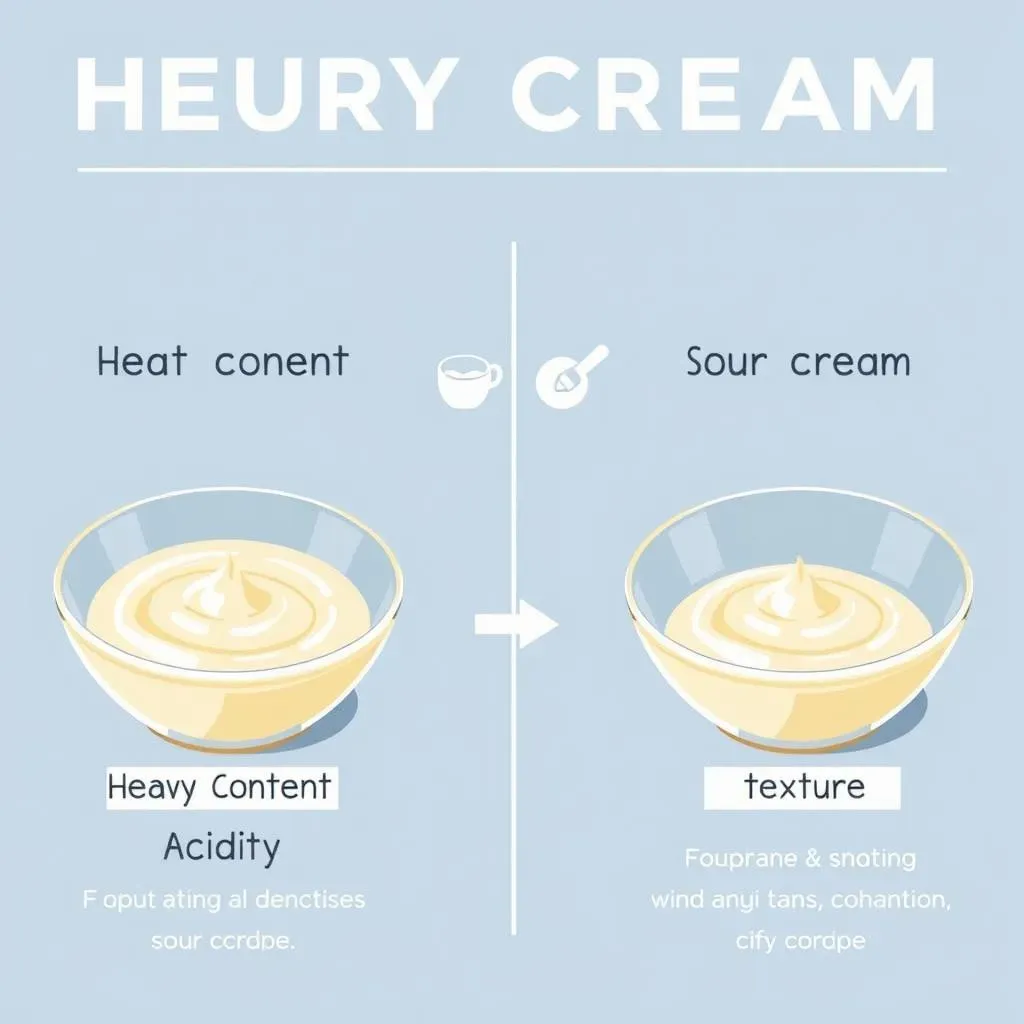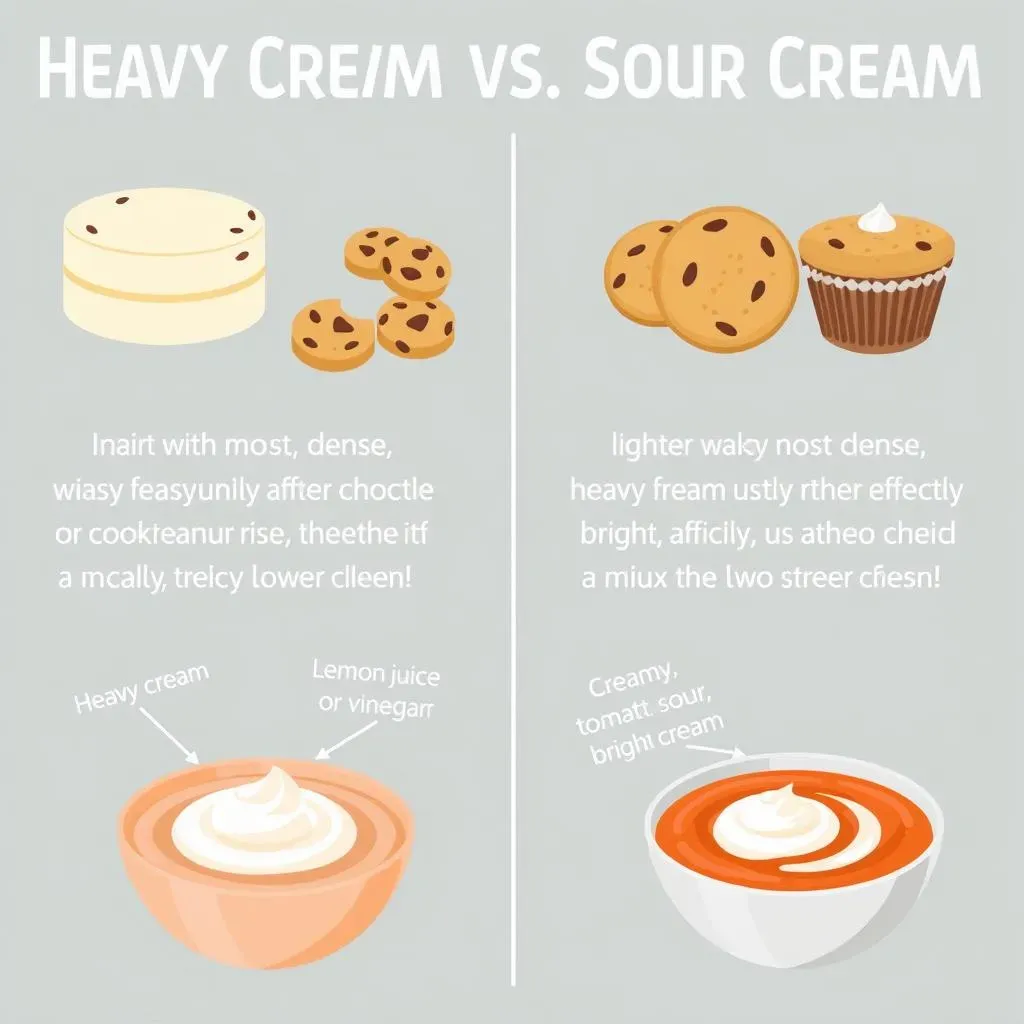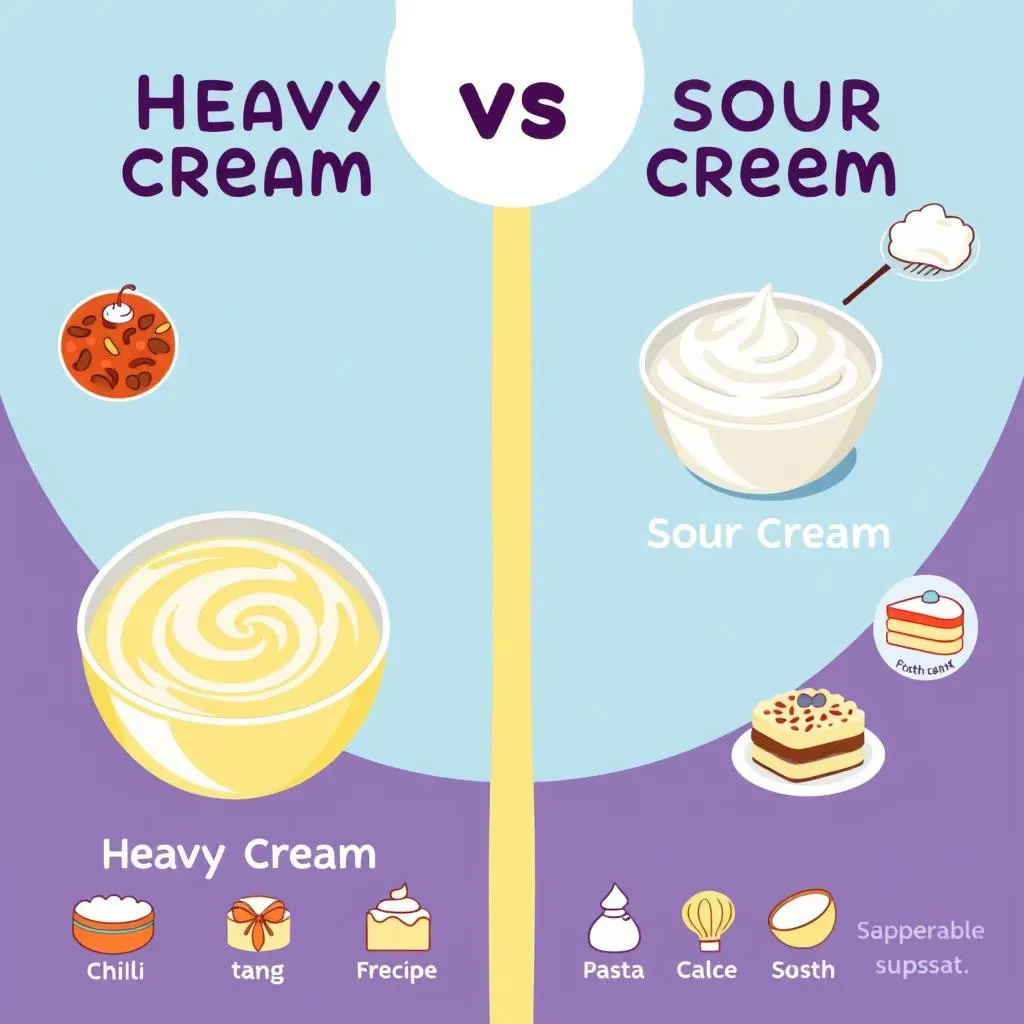Table of Contents
Ever stared blankly at a recipe, realizing you're missing a key ingredient – sour cream? And your fridge is overflowing with heavy cream? The question burning in your mind: can heavy cream be substituted for sour cream? This article will answer that creamy conundrum definitively. We'll explore the similarities and differences between these two dairy delights, examining their composition, texture, and taste. You'll learn how their distinct properties affect baking, cooking, and various culinary creations. We'll compare the results of swapping one for the other, providing practical guidance and tips to ensure your dishes don't turn into a culinary catastrophe. By the end, you'll confidently navigate the world of dairy substitutions, knowing precisely when and how to use heavy cream as a sour cream stand-in, and when to stick to the original recipe. So, let's dive into the delicious details and unravel the mystery behind this common kitchen query: can heavy cream be substituted for sour cream? Get ready to become a dairy substitution expert!
Can Heavy Cream Replace Sour Cream? A Direct Comparison

Can Heavy Cream Replace Sour Cream? A Direct Comparison
Fat Content: The Core Difference
Let's start with the most significant difference: fat content. Heavy cream boasts a whopping 36% fat, while sour cream typically contains around 20%. This higher fat content in heavy cream gives it a richer, thicker texture. It's what makes it ideal for whipping into luscious whipped cream. Sour cream, on the other hand, gets its creamy texture from a combination of milk solids and added bacteria cultures, giving it a tangy flavor. This difference in fat and texture greatly influences how each behaves in recipes.
Think of it like this: heavy cream is the heavyweight champion, all muscle and richness. Sour cream is the nimble lightweight, quick and tangy. Knowing which one is best for your recipe is key. For example, if you’re whipping up a batch of pancakes and want extra richness, heavy cream could work. But if you're making a dip for your potato chips, the tang of sour cream is better suited.
Acidity: The Tang Factor
Sour cream's signature tang comes from the bacterial cultures used in its production. This acidity is crucial in many recipes, acting as a leavening agent in some baked goods or balancing the richness of certain dishes. Heavy cream, lacking this natural acidity, can leave your dish feeling a bit flat in comparison. If you’re using heavy cream as a substitute, you might need to add a touch of lemon juice or vinegar to mimic sour cream's acidity. It's a simple adjustment, but an important one.
Consider this: If you're making a creamy tomato soup, the acidity of sour cream cuts through the richness of the tomatoes. Heavy cream would make a lovely soup, but it might lack that brightness. For more info on other substitutes, check out our guide on substituting Greek yogurt.
Ingredient | Fat Content (%) | Acidity |
|---|---|---|
Heavy Cream | 36 | Low |
Sour Cream | 20 | High |
Texture and Consistency: A Visual Comparison
The difference in fat content directly impacts texture. Heavy cream is much thicker and richer than sour cream; it's more luxurious, almost velvety. Sour cream has a lighter, slightly thinner consistency; it’s easier to spread and less likely to overwhelm a dish. When substituting, bear this in mind. In some recipes, the thicker texture of heavy cream might be advantageous, while in others, it could lead to a heavy, dense result. You'll need to adjust accordingly.
Think of it this way: Heavy cream is like a rich, decadent chocolate mousse, while sour cream is like a light and fluffy cloud. Knowing the desired texture is crucial for making the right choice. For more information on other cream cheese substitutes, check out our ultimate guide.
- Heavy Cream: Thick, rich, velvety
- Sour Cream: Lighter, thinner, spreadable
Substituting Heavy Cream for Sour Cream in Baking and Cooking

Substituting Heavy Cream for Sour Cream in Baking and Cooking
Baking: Cakes, Cookies, and More
In baking, sour cream adds moisture and a subtle tang. Heavy cream, being much richer, can make baked goods denser and potentially sweeter. When substituting, a 1:1 ratio might work, but you may need to reduce the amount of other liquids, like milk or buttermilk, to compensate for the extra richness. For example, if a recipe calls for 1 cup of sour cream, try using ¾ cup of heavy cream and adjusting other liquids accordingly. Experiment! Start small and see how it goes. Each recipe will react differently.
Remember, heavy cream's high fat content can also affect the texture of your baked goods. It can make cakes moister but also potentially denser. Cookies might become chewier, and muffins may rise slightly less. Don't be afraid to tweak the recipe to achieve your desired result. For instance, if your cookies are turning out too dense, try reducing the amount of heavy cream slightly in your next batch. For more info on using Greek yogurt, check out our guide on Greek yogurt substitutions in baking.
- Cakes: May be moister, potentially denser
- Cookies: May be chewier
- Muffins: May rise less
Cooking: Sauces, Soups, and Dips
In savory dishes, sour cream's acidity balances richness and adds a tangy kick. Heavy cream, while rich, lacks that acidic bite. When substituting in sauces, soups, or dips, you might need to add a splash of lemon juice or white vinegar (about ½ teaspoon per cup of heavy cream) to replicate the sour cream's tang. This simple addition can elevate your dish from bland to bold.
Consider this: in a creamy tomato soup, sour cream adds brightness and depth. Heavy cream would create a rich soup, but the flavor might feel a bit one-dimensional. A little lemon juice in the heavy cream version would give it the extra zing it needs! Remember, experimentation is key. If you are looking for another substitute, you can check out our guide on cream cheese substitutes.
Dish | Sour Cream Effect | Heavy Cream Effect (with adjustment) |
|---|---|---|
Tomato Soup | Adds brightness and tang | Rich and creamy (add lemon juice) |
Chili | Adds creaminess and tang | Adds richness (add a touch of vinegar) |
Important Considerations for Substitution
Remember, heavy cream is significantly richer than sour cream. This means that substituting it directly may drastically alter the flavor and texture of your dish. It's always best to start with a smaller amount of heavy cream and add more gradually until you achieve the desired consistency and taste. Don't be afraid to experiment; cooking is all about finding what works best for you and your palate.
Also, consider the overall flavor profile of your recipe. If the recipe relies heavily on the sour cream’s tang, heavy cream might not be the best option. In such cases, other substitutes like Greek yogurt (check out our article on using Greek yogurt as a substitute) or even buttermilk might be more suitable. Ultimately, the best substitute depends on the specific recipe and your desired outcome.
Heavy Cream vs. Sour Cream: Taste, Texture, and Culinary Applications

Heavy Cream vs. Sour Cream: Taste, Texture, and Culinary Applications
Let's talk taste! Sour cream's hallmark is its tangy, slightly acidic flavor. It's bright and refreshing, perfect for cutting through richness in dishes like chili or adding a zing to dips. Heavy cream, on the other hand, is all about richness and creaminess. Its taste is mild, almost buttery, lending a luxurious mouthfeel to sauces and baked goods. This fundamental difference in taste dictates how each ingredient functions in a recipe. Using one in place of the other will significantly impact the final flavor profile.
Think of it like this: sour cream is the spicy salsa to your bland tortilla chips – adding a kick of flavor. Heavy cream is the smooth, creamy peanut butter to your crunchy celery sticks – adding richness and texture. The choice depends entirely on the desired taste and texture of your dish. If you need a dairy substitute, consider checking out our guide on Greek yogurt substitutes.
- Sour Cream: Tangy, acidic, bright
- Heavy Cream: Rich, creamy, buttery
Now, let's discuss texture. Sour cream's texture is relatively thin and spreadable. It's light and airy, making it ideal for toppings and dips. Heavy cream, with its high fat content, is significantly thicker and richer. It's luxurious and velvety, perfect for creating whipped cream or adding a decadent richness to sauces. This textural difference is crucial when considering substitutions. Heavy cream's thickness might make some recipes too dense, while sour cream's thinness might not provide the desired richness in others.
Consider this: a creamy pasta sauce made with sour cream will have a lighter, brighter texture. A sauce made with heavy cream will be richer and more decadent. The best choice depends on the desired mouthfeel. For recipes that need a tangy flavor, check out our guide on buttermilk substitutes.
Characteristic | Sour Cream | Heavy Cream |
|---|---|---|
Texture | Thin, spreadable | Thick, rich |
Mouthfeel | Light, airy | Luxurious, velvety |
Finally, let's explore culinary applications. Sour cream shines in dishes where a tangy, slightly acidic element is desired. Think dips, toppings for chili or tacos, or as an ingredient in creamy potato salads. Its acidity also acts as a natural leavening agent in some baked goods. Heavy cream, on the other hand, is a star in recipes where richness and creaminess are key. It's perfect for making whipped cream, adding richness to sauces, soups, and stews, or as an ingredient in cakes and other baked goods. The versatility of both is impressive, but their applications differ significantly.
Remember, successful substitution relies on understanding these differences. Choosing the right dairy product depends heavily on the specific recipe and your desired outcome. For instance, if you are looking for a healthier substitute, you can check out our guide on cottage cheese substitutes.